

Compact Muon Solenoid
LHC, CERN
| CMS-FSQ-16-002 ; CERN-EP-2016-313 | ||
| Measurement of the inclusive energy spectrum in the very forward direction in proton-proton collisions at $ \sqrt{s} = $ 13 TeV | ||
| CMS Collaboration | ||
| 30 January 2017 | ||
| J. High Energy Phys. 08 (2017) 046 | ||
| Abstract: The differential cross section for inclusive particle production as a function of energy in proton-proton collisions at a center-of-mass energy of 13 TeV is measured in the very forward region of the CMS detector. The measurement is based on data collected with the CMS apparatus at the LHC, and corresponds to an integrated luminosity of 0.35 $\mu$b$^{-1}$. The energy is measured in the CASTOR calorimeter, which covers the pseudorapidity region $-6.6<\eta<-5.2$. The results are given as a function of the total energy deposited in CASTOR, as well as of its electromagnetic and hadronic components. The spectra are sensitive to the modeling of multiparton interactions in pp collisions, and provide new constraints for hadronic interaction models used in collider and in high energy cosmic ray physics. | ||
| Links: e-print arXiv:1701.08695 [hep-ex] (PDF) ; CDS record ; inSPIRE record ; HepData record ; CADI line (restricted) ; | ||
| Figures & Tables | Summary | Additional Figures | References | CMS Publications |
|---|
| Figures | |

png pdf |
Figure 1:
Spectra of the energy reconstructed in CASTOR, normalized to the number of events that pass the offline event selection, compared to the detector-level predictions of various event generators. The total energy spectrum is shown in the left panel, the electromagnetic in the middle, and the hadronic in the right. Statistical (systematic) uncertainties are shown with error bars (yellow band, discussed in Section 4). |

png pdf |
Figure 1-a:
Spectra of the energy reconstructed in CASTOR, normalized to the number of events that pass the offline event selection, compared to the detector-level predictions of various event generators. The total energy spectrum is shown. Statistical (systematic) uncertainties are shown with error bars (yellow band, discussed in Section 4). |
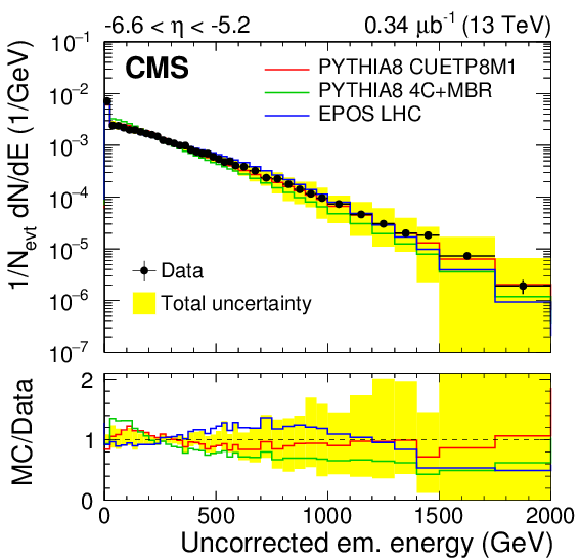
png pdf |
Figure 1-b:
Spectra of the energy reconstructed in CASTOR, normalized to the number of events that pass the offline event selection, compared to the detector-level predictions of various event generators. The electromagnetic energy spectrum is shown. Statistical (systematic) uncertainties are shown with error bars (yellow band, discussed in Section 4). |

png pdf |
Figure 1-c:
Spectra of the energy reconstructed in CASTOR, normalized to the number of events that pass the offline event selection, compared to the detector-level predictions of various event generators. The hadronic energy spectrum is shown. Statistical (systematic) uncertainties are shown with error bars (yellow band, discussed in Section 4). |

png pdf |
Figure 2:
Distributions of reconstructed energy as a function of the particle-level energy for PYTHIA 8 CUETP8M1 for the total (left), electromagnetic (middle), and hadronic (right) energy in CASTOR. The color indicates the number of events. The selection $\xi > 10^{-6}$ is explained in the text. |

png pdf |
Figure 3:
Differential cross section as a function of the total energy in the region $-6.6<\eta < -5.2$ for events with $\xi >10^{-6}$. The left panel shows the data compared to MC event generators mostly developed for cosmic ray induced air showers, and the right panel to different PYTHIA 8 tunes. |

png pdf |
Figure 3-a:
Differential cross section as a function of the total energy in the region $-6.6<\eta < -5.2$ for events with $\xi >10^{-6}$. The panel shows the data compared to MC event generators mostly developed for cosmic ray induced air showers. |
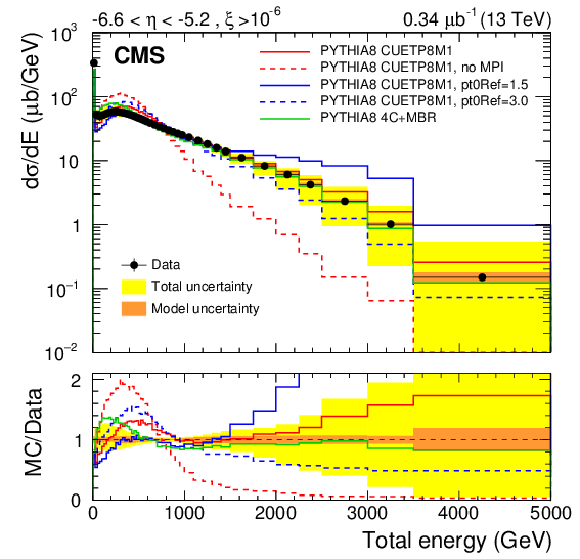
png pdf |
Figure 3-b:
Differential cross section as a function of the total energy in the region $-6.6<\eta < -5.2$ for events with $\xi >10^{-6}$. The panel shows the data compared to different PYTHIA 8 tunes. |

png pdf |
Figure 4:
Differential cross section as a function of the electromagnetic energy in the region $-6.6<\eta < -5.2$ for events with $\xi >10^{-6}$. The left panel shows the data compared to MC event generators mostly developed for cosmic ray induced air showers, and the right panel to different PYTHIA 8 tunes. |
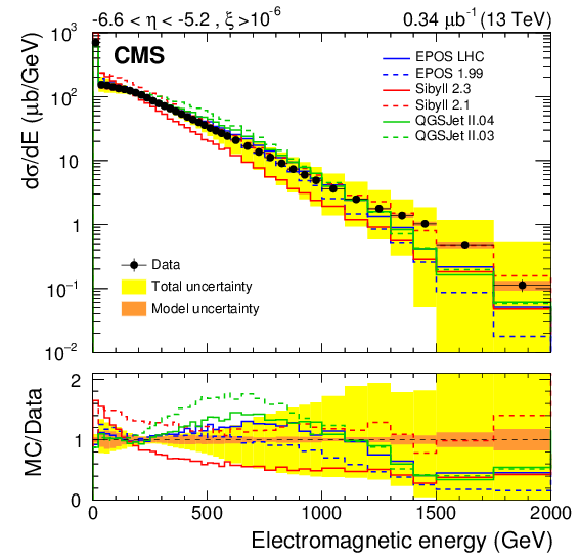
png pdf |
Figure 4-a:
Differential cross section as a function of the electromagnetic energy in the region $-6.6<\eta < -5.2$ for events with $\xi >10^{-6}$. The panel shows the data compared to MC event generators mostly developed for cosmic ray induced air showers. |
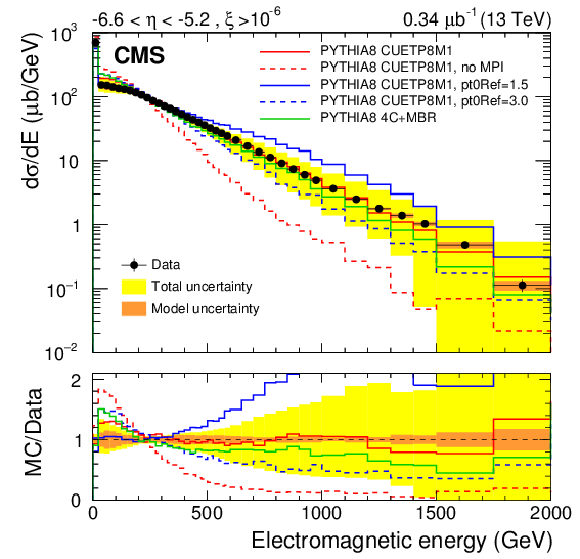
png pdf |
Figure 4-b:
Differential cross section as a function of the electromagnetic energy in the region $-6.6<\eta < -5.2$ for events with $\xi >10^{-6}$. The panel shows the data compared to different PYTHIA 8 tunes. |
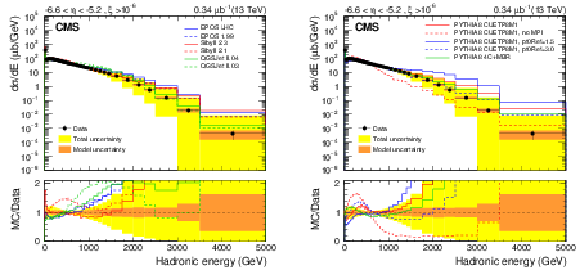
png pdf |
Figure 5:
Differential cross section as a function of the hadronic energy in the region $-6.6<\eta < -5.2$ for events with $\xi >10^{-6}$. The left panel shows the data compared to MC event generators mostly developed for cosmic ray induced air showers, and the right panel to different PYTHIA 8 tunes. |

png pdf |
Figure 5-a:
Differential cross section as a function of the hadronic energy in the region $-6.6<\eta < -5.2$ for events with $\xi >10^{-6}$. The panel shows the data compared to MC event generators mostly developed for cosmic ray induced air showers. |
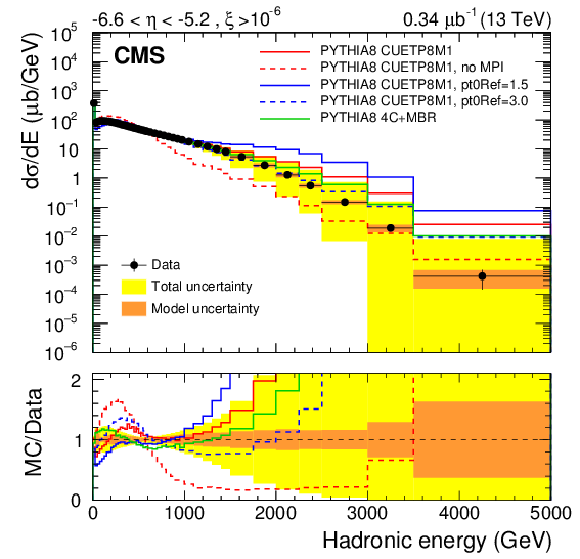
png pdf |
Figure 5-b:
Differential cross section as a function of the hadronic energy in the region $-6.6<\eta < -5.2$ for events with $\xi >10^{-6}$. The panel shows the data compared to different PYTHIA 8 tunes. |
| Tables | |

png pdf |
Table 1:
Uncertainties on the differential cross sections at a few selected values of the total, electromagnetic, and hadronic energies. |
| Summary |
| The electromagnetic, hadronic, and total energy spectra of particles produced at very forward pseudorapidities ($-6.6<\eta < -5.2$) have been measured with the CASTOR calorimeter of the CMS experiment in proton-proton collisions at a center-of-mass energy of 13 TeV. The experimental distributions, fully corrected for detector effects, are compared to the predictions of various Monte Carlo event generators commonly used in high energy cosmic ray physics (EPOS, QGSJetII, and Sibyll), and those of different tunes of PYTHIA 8. None of the generators considered describe all features seen in the data. The present measurements are particularly sensitive to the modeling of multiparton interactions (MPI) that dominate particle production in the underlying event at forward rapidities in pp collisions. PYTHIA 8 CUETP8M1 without MPI is ruled out by the data, which exhibit much harder spectra than predicted by the model. The shape of the spectra are significantly influenced by the MPI-related settings in PYTHIA 8. The present results can therefore contribute to improvements in future Monte Carlo parameter tunes. Event generators developed for modeling high energy cosmic ray air showers, tuned to LHC measurements at 0.9, 7, and 8 TeV, agree better with the present data than those tuned to Tevatron results alone. This is especially true for QGSJetII and Sibyll. However, all these models underestimate the muon production rate in extensive air showers because of their inaccurate description of the hadronic shower component [31]. The present results provide new constraints for improving the modeling of hadron production in event generators commonly used in high energy particle and cosmic ray physics. |
| Additional Figures | |

png pdf |
Additional Figure 1:
The distribution of the ratio of electromagnetic to total reconstructed energy in CASTOR. The error bars denote statistical uncertainties, while the yellow band indicates the systematic uncertainty. The data without correction for any detector effect agree within experimental uncertainties with event generator predictions after a full GEANT4 detector simulation. |

png pdf |
Additional Figure 2:
Distributions of reconstructed energy as a function of the particle-level energy for EPOS LHC for the total (left), electromagnetic (middle), and hadronic (right) energy in CASTOR. The color indicates the number of events. The selection $\xi > 10^{-6}$ is explained in the paper. |

png pdf |
Additional Figure 3:
Distributions of reconstructed energy as a function of the particle-level energy for PYTHIA 8 4C+MBR for the total (left), electromagnetic (middle), and hadronic (right) energy in CASTOR. The color indicates the number of events. The selection $\xi > 10^{-6}$ is explained in the paper. |
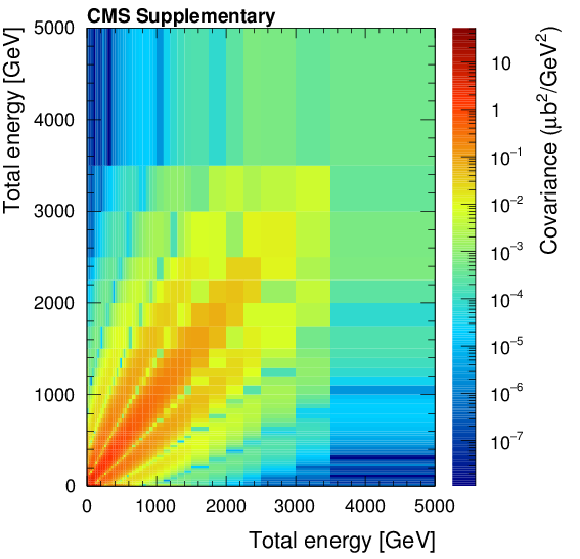
png pdf |
Additional Figure 4:
Statistical covariance matrix of the total energy spectrum. For illustration, absolute values are shown. |

png pdf |
Additional Figure 5:
Statistical covariance matrix of the electromagnetic energy spectrum. For illustration, absolute values are shown. |

png pdf |
Additional Figure 6:
Statistical covariance matrix of the hadronic energy spectrum. For illustration, absolute values are shown. |
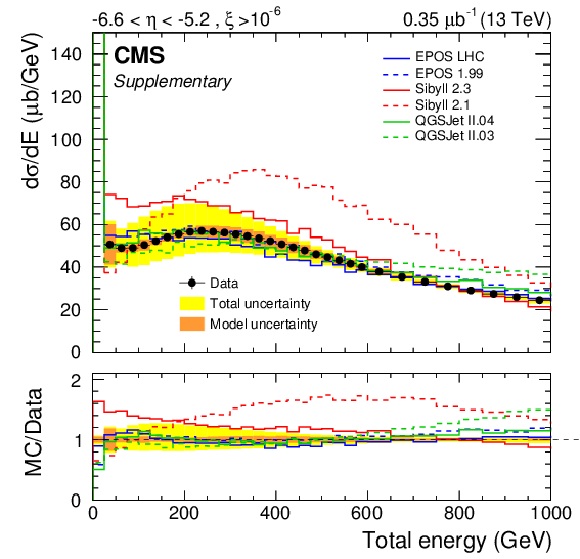
png pdf |
Additional Figure 6-a:
Statistical covariance matrix of the hadronic energy spectrum. For illustration, absolute values are shown. |
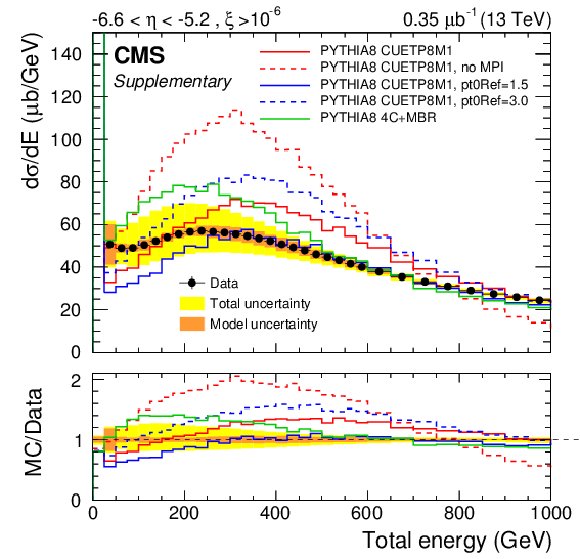
png pdf |
Additional Figure 6-b:
Statistical covariance matrix of the hadronic energy spectrum. For illustration, absolute values are shown. |
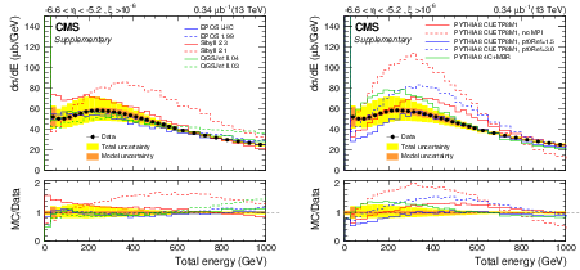
png pdf |
Additional Figure 7:
Differential cross section as a function of the total energy in the region $-6.6<\eta < -5.2$ for events with $\xi >10^{-6}$, zoomed into the low energy region. Panel (a) shows the data compared to MC event generators mostly developed for cosmic ray induced air showers, and panel (b) to different PYTHIA 8 tunes. |
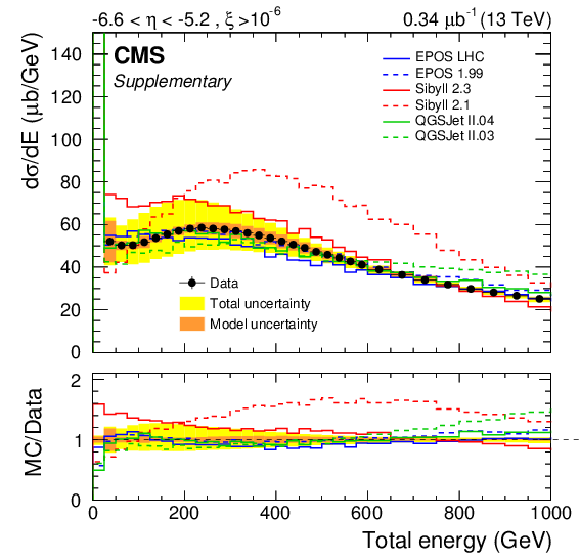
png pdf |
Additional Figure 7-a:
Differential cross section as a function of the total energy in the region $-6.6<\eta < -5.2$ for events with $\xi >10^{-6}$, zoomed into the low energy region. The panel shows the data compared to MC event generators mostly developed for cosmic ray induced air showers. |
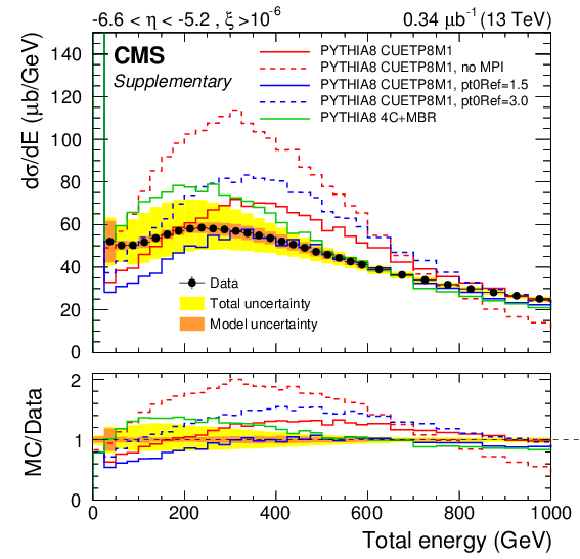
png pdf |
Additional Figure 7-b:
Differential cross section as a function of the total energy in the region $-6.6<\eta < -5.2$ for events with $\xi >10^{-6}$, zoomed into the low energy region. The panel shows the data compared to different PYTHIA 8 tunes. |
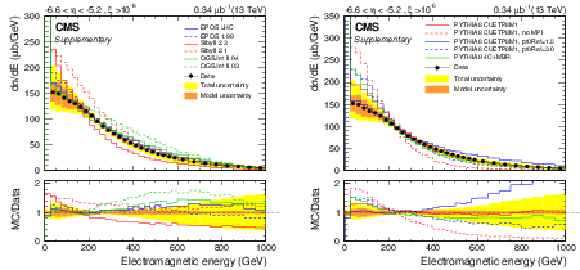
png pdf |
Additional Figure 8:
Differential cross section as a function of the electromagnetic energy in the region $-6.6<\eta < -5.2$ for events with $\xi >10^{-6}$, zoomed into the low energy region. Panel (a) shows the data compared to MC event generators mostly developed for cosmic ray induced air showers, and panel (b) to different PYTHIA 8 tunes. |

png pdf |
Additional Figure 8-a:
Differential cross section as a function of the electromagnetic energy in the region $-6.6<\eta < -5.2$ for events with $\xi >10^{-6}$, zoomed into the low energy region. The panel shows the data compared to MC event generators mostly developed for cosmic ray induced air showers. |
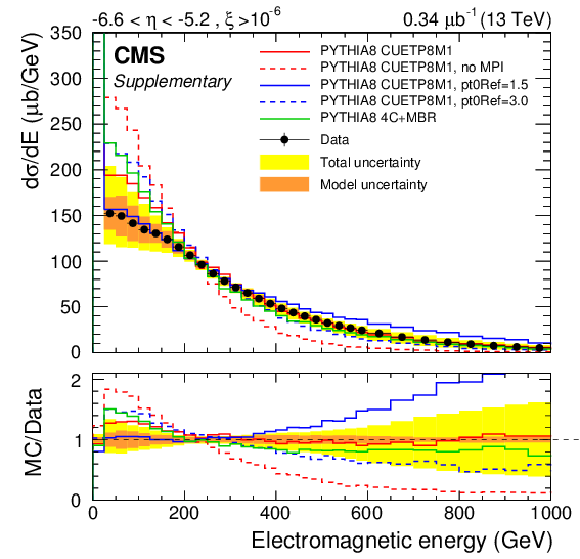
png pdf |
Additional Figure 8-b:
Differential cross section as a function of the electromagnetic energy in the region $-6.6<\eta < -5.2$ for events with $\xi >10^{-6}$, zoomed into the low energy region. The panel shows the data compared to different PYTHIA 8 tunes. |
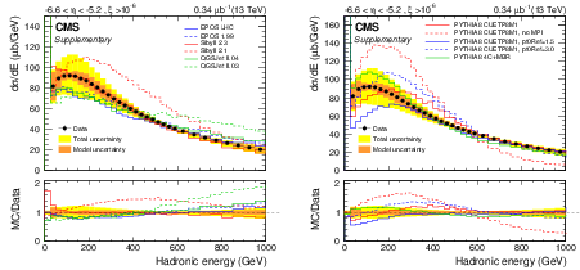
png pdf |
Additional Figure 9:
Differential cross section as a function of the hadronic energy in the region $-6.6<\eta < -5.2$ for events with $\xi >10^{-6}$, zoomed into the low energy region. Panel (a) shows the data compared to MC event generators mostly developed for cosmic ray induced air showers, and panel (b) to different PYTHIA 8 tunes. |

png pdf |
Additional Figure 9-a:
Differential cross section as a function of the hadronic energy in the region $-6.6<\eta < -5.2$ for events with $\xi >10^{-6}$, zoomed into the low energy region. The panel shows the data compared to MC event generators mostly developed for cosmic ray induced air showers. |
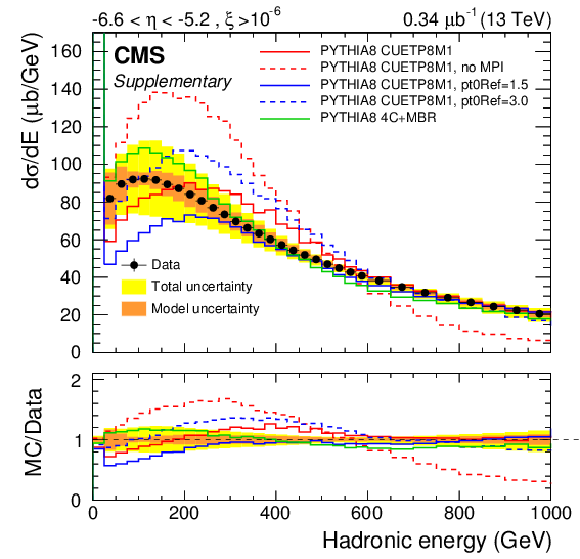
png pdf |
Additional Figure 9-b:
Differential cross section as a function of the hadronic energy in the region $-6.6<\eta < -5.2$ for events with $\xi >10^{-6}$, zoomed into the low energy region. The panel shows the data compared to different PYTHIA 8 tunes. |
| References | ||||
| 1 | K. Akiba et al. | LHC forward physics | JPG 43 (2016) 110201 | 1611.05079 |
| 2 | CDF Collaboration and R. Field | The underlying event in hard scattering processes | in Proceedings, APS / DPF / DPB Summer Study on the Future of Particle Physics (Snowmass 2001) | hep-ph/0201192 |
| 3 | T. Sjostrand and M. van Zijl | A multiple interaction model for the event structure in hadron collisions | PRD 36 (1987) 2019 | |
| 4 | R. Corke and T. J. Sjostrand | Interleaved parton showers and tuning prospects | JHEP 03 (2011) 032 | 1011.1759 |
| 5 | P. Skands, S. Carrazza, and J. Rojo | Tuning PYTHIA 8.1: the Monash 2013 tune | EPJC 74 (2014) 3024 | 1404.5630 |
| 6 | R. Ulrich, R. Engel, and M. Unger | Hadronic multiparticle production at ultra-high energies and extensive air showers | PRD 83 (2011) 054026 | 1010.4310 |
| 7 | Pierre Auger Collaboration | Muons in air showers at the Pierre Auger Observatory: Mean number in highly inclined events | PRD 91 (2015) 032003 | 1408.1421 |
| 8 | CMS Collaboration | Study of the underlying event at forward rapidity in pp collisions at $ \sqrt{s} = $ 0.9, 2.76, and 7 TeV | JHEP 04 (2013) 072 | CMS-FWD-11-003 1302.2394 |
| 9 | CMS, TOTEM Collaboration | Measurement of pseudorapidity distributions of charged particles in proton-proton collisions at $ \sqrt{s} = $ 8 TeV by the CMS and TOTEM experiments | EPJC 74 (2014), no. 10 | 1405.0722 |
| 10 | TOTEM Collaboration | Measurement of the forward charged particle pseudorapidity density in $ pp $ collisions at $ \sqrt{s} = $ 7 TeV with the TOTEM experiment | Europhys. Lett. 98 (2012) 31002 | 1205.4105 |
| 11 | TOTEM Collaboration | Measurement of the forward charged particle pseudorapidity density in pp collisions at $ \sqrt{s} = $ 8 TeV using a displaced interaction point | EPJC 75 (2015), no. 3, 126 | 1411.4963 |
| 12 | LHCf Collaboration | Measurement of zero degree single photon energy spectra for $ \sqrt{s} = $ 7 TeV proton-proton collisions at LHC | PLB 703 (2011) 128 | 1104.5294 |
| 13 | LHCf Collaboration | Measurement of very forward neutron energy spectra for 7 TeV proton-proton collisions at the Large Hadron Collider | PLB 750 (2015) 360 | 1503.03505 |
| 14 | V. Andreev et al. | Performance studies of a full-length prototype for the CASTOR forward calorimeter at the CMS experiment | EPJC 67 (2010) 601 | |
| 15 | CMS Collaboration | The CMS experiment at the CERN LHC | JINST 3 (2008) S08004 | CMS-00-001 |
| 16 | CMS Collaboration | The CMS trigger system | JINST 12 (2017), no. 01, P01020 | CMS-TRG-12-001 1609.02366 |
| 17 | GEANT4 Collaboration | GEANT4---a simulation toolkit | NIMA 506 (2003) 250 | |
| 18 | T. Sjostrand et al. | An introduction to PYTHIA 8.2 | CPC 191 (2015) 159 | 1410.3012 |
| 19 | CMS Collaboration | Event generator tunes obtained from underlying event and multiparton scattering measurements | EPJC 76 (2016) 155 | CMS-GEN-14-001 1512.00815 |
| 20 | R. Ciesielski and K. Goulianos | MBR Monte Carlo simulation in PYTHIA8 | in Proceedings, 36th International Conference on High Energy Physics (ICHEP2012) | 1205.1446 |
| 21 | NNPDF Collaboration | Parton distributions with QED corrections | NPB 877 (2013) 290 | 1308.0598 |
| 22 | CTEQ Collaboration | Global QCD analysis of parton structure of the nucleon: CTEQ5 parton distributions | EPJC 12 (2000) 375 | hep-ph/9903282 |
| 23 | T. Pierog et al. | EPOS LHC: Test of collective hadronization with data measured at the CERN Large Hadron Collider | PRC 92 (2015) 034906 | 1306.0121 |
| 24 | T. Pierog and K. Werner | EPOS model and ultra high energy cosmic rays | NPB - Proc. Suppl. 196 (2009) 102 | 0905.1198v1 |
| 25 | S. Ostapchenko | Monte carlo treatment of hadronic interactions in enhanced pomeron scheme: QGSJET-II model | PRD 83 (2011) 014018 | 1010.1869 |
| 26 | E.-J. Ahn et al. | Cosmic ray interaction event generator SIBYLL 2.1 | PRD 80 (2009) 094003 | |
| 27 | F. Riehn et al. | A new version of the event generator Sibyll | in Proceedings, 34th International Cosmic Ray Conference (ICRC 2015) The Hague 2016 | 1510.00568 |
| 28 | D. d'Enterria et al. | Constraints from the first LHC data on hadronic event generators for ultra-high energy cosmic-ray physics | Astropart. Phys. 35 (2011) 98 | 1101.5596 |
| 29 | P. Gottlicher, for the CMS-CASTOR Collaboration | Design and test beam studies for the CASTOR calorimeter of the CMS experiment | NIMA 623 (2010) 225 | |
| 30 | CMS Collaboration | Measurement of energy flow at large pseudorapidities in pp collisions at $ \sqrt{s} = $ 0.9 and 7 TeV | JHEP 11 (2011) 148 | CMS-FWD-10-011 1110.0211 |
| 31 | T. Adye | Unfolding algorithms and tests using RooUnfold | in Proceedings of the PHYSTAT 2011 Workshop, CERN 2011, CERN-2011-006 | 1105.1160 |
| 32 | G. D'Agostini | A multidimensional unfolding method based on Bayes' theorem | NIMA 362 (1995) 487 | |
| 33 | CMS Collaboration | CMS luminosity measurement for the 2015 data taking period | CMS-PAS-LUM-15-001 | CMS-PAS-LUM-15-001 |
| 34 | The Durham HEP Group | The Durham High Energy Physics Database | link | |
| 35 | Pierre Auger Collaboration | Testing hadronic interactions at ultrahigh energies with air showers measured by the Pierre Auger Observatory | PRL 117 (2016) 192001 | 1610.08509 |

|
Compact Muon Solenoid LHC, CERN |

|

|

|

|

|

|